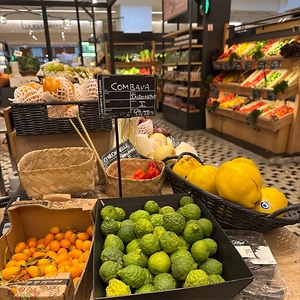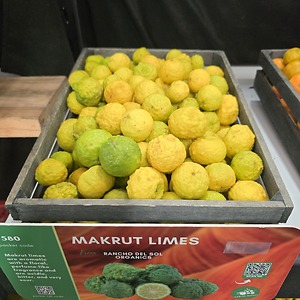


Makrut Limes
Estimated Inventory, lb : 0
Description/Taste
Makrut limes are small in size, averaging 3 to 7 centimeters in diameter, and are round, ovoid, to oval in shape with one slightly protruding nipple on the stem end. The fruits are curved, and the thick rind is textured and semi-rough, covered in prominent creases, wrinkles, and ridges. Makrut limes are typically harvested for culinary use in their green stage. If left to mature, the fruits transition into yellow-green and pale yellow hues. The surface is also covered in sunken oil glands that release aromatic essential oils when scratched. Underneath the rind, the pale yellow to yellow-green flesh is dry and low in juice, divided into 10 to 12 segments by thin membranes. The flesh also contains cream-colored, elliptic to oblong seeds ranging from 1 to 1.5 centimeters in length. Makrut limes are utilized in culinary preparations for their zest and juice. The zest from the rind releases a bright, floral, citrusy, and refreshing aroma, while the juice has an acidic, sour, bitter, sharp, and tangy taste.
Seasons/Availability
Makrut limes are available year-round, with a peak season in the late winter through early spring.
Current Facts
Makrut limes, botanically classified as Citrus hystrix, are a fragrant Southeast Asian species belonging to the Rutaceae or Citrus family. The small, distinctly wrinkled fruits develop on evergreen trees reaching 2 to 10 meters in height and are an ancient, hardy species foraged for use in culinary, medicinal, and cultural practices. The species is also cultivated for its fragrant leaves. Makrut limes are known by several names worldwide, including Kaffir lime, Thai lime, Caffre lime, and Mauritius papeda. It is important to note that the species is often sold under the kaffir moniker in retail markets, but this name is considered controversial among some communities. Historians believe kaffir was selected and given to the fruits after a people group of the same name in Sri Lanka. In other regions of the world, kaffir is derived from the Arabic word “kafara,” meaning “infidel.” This word is an offensive and derogatory term, and due to this, the species is now referred to as Makrut. Throughout history, Makrut limes have been a treasured species in Asia and have expanded in cultivation worldwide. The leaves are the portion of the tree that is most used for culinary use, followed by the zest and juice of the fruits.
Nutritional Value
Makrut limes are valued for their antioxidant, antimicrobial, and anti-inflammatory properties. The species is a source of vitamin C to strengthen the immune system and fiber to regulate the digestive tract. Makrut limes are also used for their aromatic essential oils as a natural purifying ingredient in shampoos, household cleaners, and skincare products. The juice is customarily rubbed on feet and legs to prevent leech and insect bites, and the juice is sometimes used to clean jewelry. Portions of the fruit are also used in bathrooms in Thailand as an air freshener. In Southeast Asia, Makrut limes are incorporated into natural remedies to lessen colds, soothe headaches, and fight against fatigue.
Applications
Makrut limes are known for their intensely fragrant rind and are used as a finishing element in culinary dishes. The fruit is not commonly eaten due to its bitter, acidic, and intense flavor. Only the juice and zested rind are incorporated sparingly into raw and cooked dishes. Makrut limes are popularly zested or chopped and mashed with other ingredients into curry pastes, soups, and stews. They are also utilized in stir-fries, and the rind’s sharp flavoring helps cut through the richness of strong spices and coconut milk in Southeast Asian dishes. Makrut limes are often used in tom yum preparations, a spicy, sour, rich, and savory soup in Thailand. The zest is also added to gaeng pa, also known as Thai jungle curry, infused into rice dishes, or added to fish cakes. While less common, the rind is candied into a fragrant sweet treat, or used to flavor custards, cakes, pudding, and ice cream. In Cambodia, Makrut limes are combined in kroeung, a spice-centric paste that helps flavor a wide variety of dishes. In addition to culinary preparations, Makrut limes are infused into vodka and rum for added flavoring, muddled into cocktails, or steeped into tea. The leaves of the tree are also prevalently used in culinary dishes and are frequently combined with the zest in dishes. Makrut limes pair well with meats such as poultry, pork, beef, and seafood, spices such as cumin, cardamom, and turmeric, and herbs including galangal, ginger, Thai basil, and lemongrass. Whole, unwashed Makrut limes will keep for several weeks when stored in a sealed container in the refrigerator.
Ethnic/Cultural Info
Makrut limes are traditionally used during Songkran, a multi-day festival celebrated across Thailand. Songkran is also known as the Thai New Year and is annually held over the first full moon in April. The word Songkran is derived from Sanskrit, meaning “pass into” or “enter,” and this name describes how the festival is determined each year by the lunisolar Theravada Buddhist calendar. Songkran is celebrated for 3 to 10 days, depending on the region in Thailand. It is also a time when families gather together to pay their respects to elders and cleanse the soul and body through water. Makrut lime fruits and leaves are infused into water as a cleansing agent with a pleasant aroma. This water is splashed on the body as a symbol of new beginnings and cleansing from bad luck. Infused water is also used in Song Nam Phra, a Buddhist religious ceremony where water is poured over statues and symbols of Buddha to welcome prosperity and fortune while washing away impurities.
Geography/History
Makrut limes are thought to be native to Southeast Asia and have been growing wild since ancient times. The species’ specific center of origin is unknown within Southeast Asia, but the aromatic fruit and leaves are harvested for various uses throughout Thailand, Laos, Indonesia, the Philippines, Malaysia, Vietnam, and Cambodia. Over time, Citrus hystrix was taken from the wild and planted in home and village gardens. It was later domesticated for commercial production and expanded in cultivation into Southern and East Asia. The species was planted on the island of Mauritius sometime around 1770 and was eventually taken from Southeast Asian islands to Paris, France, by French naturalists. Sometime before the late 19th century, Citrus hystrix was introduced into Sri Lanka and India and was initially used as a natural bug repellant. Citrus hystrix has naturalized in tropical and subtropical regions worldwide through human introduction, and the species is thought to have hybridized with other species within the subgenus Papeda for slight variation. Today, Citrus hystrix is still found in the wild in its native growing region and is cultivated on a small scale in commercial and home gardens.
Recipe Ideas
Recipes that include Makrut Limes. One
| Rachel Cooks Thai |
|
Thai Inspired Mini Kaffir Lime Tarts |
| Hapa Nom Nom |
|
Kaffir Cooler |
| Saveur |
|
Key Lime Curd |
| Morsels and Musings |
|
Kaffir Lume Syrup |

















